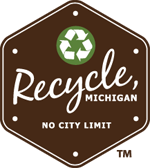Paper
Where to Recycle: Curbside and Community Drop-Offs
Become more familiar with all the paper products you can recycle in your local program by calling your local recycling contact or checking their website. Local programs may have bagging requirements for recycling paper in your bin, especially shredded paper.
Background:
Paper is manufactured most commonly from the pulp of wood. To accomplish this, trees must be harvested and chipped, combined with water, pulped, dried, and pressed into thin sheets. The method of harvesting trees varies, with some being more sustainable than others, but every method uses some amount of this finite resource. Unlike other recyclables, paper fibers have a limited recycled life. Higher-quality papers require longer fibers. The recycling and manufacturing process shortens the fibers and makes the recycled paper suitable for alternative and/or lower-quality products.
According to About Mechanics, “Deinking is an industrial process that removes ink, adhesive, and other material from recycled paper. A pulp-washing process removes small particles of ink by rinsing with a mixture of water and dispersants, which are used to break down oils. Larger particles and adhesives are removed in a flotation process. Surfactants, chemicals used to assist in cleaning, are combined with air and injected into the pulp suspension.”
What types of this material qualify for recycling?
Recyclable: office paper, junk mail, magazines, cereal boxes and paperboard, newspapers, and corrugated cardboard
Non-Recyclable: Wax-coated paper, paper coated with food, wet paper, and tissue/paper towel products
Why is it important to recycle this item?
It is estimated by the EPA that manufacturing paper from recycled content requires only 60% of the energy it would take to manufacture the same product out of raw materials.
Paper, paperboard or boxboard, and corrugated cardboard products make up the largest component of municipal solid waste generated in the United States according to the Environmental Protection Agency (EPA). In 2017, the EPA reports that 67 million tons of these materials were generated accounting for about 25% of municipal solid waste. The good news is that over 44 million tons were recycled. Unfortunately, almost 23 million tons were either landfilled or incinerated.
What is it recycled into?
cardboard, newsprints, tissue, office paper
